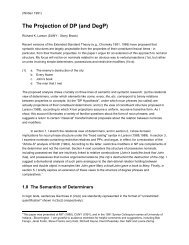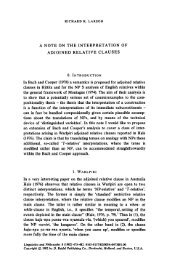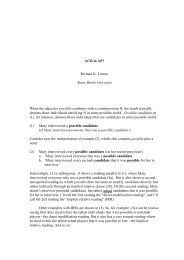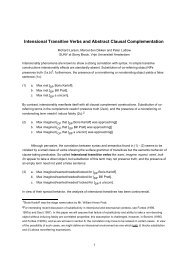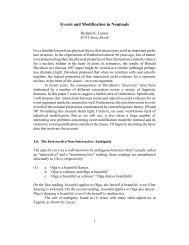Presupposition & Root Transforms in Adjunct Clauses* Miyuki ...
Presupposition & Root Transforms in Adjunct Clauses* Miyuki ...
Presupposition & Root Transforms in Adjunct Clauses* Miyuki ...
Create successful ePaper yourself
Turn your PDF publications into a flip-book with our unique Google optimized e-Paper software.
<strong>Presupposition</strong> & <strong>Root</strong> <strong>Transforms</strong> <strong>in</strong> <strong>Adjunct</strong> Clauses *<br />
<strong>Miyuki</strong> Sawada and Richard K. Larson<br />
M<strong>in</strong>g Chuan University and Stony Brook University<br />
Hooper & Thompson (1973; hereafter H&T) observe an <strong>in</strong>terest<strong>in</strong>g correlation between<br />
the syntax and pragmatics of adverbial clauses. As shown <strong>in</strong> (1a), adverbial when-,<br />
before- and after- clauses resist root transformations like Left Dislocation;<br />
correspond<strong>in</strong>gly their content is presupposed (1b). By contrast, because-clauses like<br />
those <strong>in</strong> (1b) allow Left Dislocation (2a), and their content is asserted, not presupposed:<br />
(1) a. *Mildred bought a Mercedes<br />
[ when/before/after her son, he purchased stock <strong>in</strong> Xerox ].<br />
b. Mildred bought a Mercedes<br />
[ when/before/after her son purchased stock <strong>in</strong> Xerox ].<br />
Presupposes: Mildred’s son purchased stock <strong>in</strong> Xerox.<br />
(2) a. Mildred drives a Mercedes [ because her son, he owns stock <strong>in</strong> Xerox ].<br />
b. Mildred drives a Mercedes [ because her son owns stock <strong>in</strong> Xerox ].<br />
Asserts: Mildred’s son purchased stock <strong>in</strong> Xerox.<br />
The robustness of H&T‘s correlation between root transform availability and<br />
presupposition is underscored by example (3). Here presupposition is forced on the<br />
because-clause by association with negation; notice now that Left Dislocation is blocked.<br />
(3) *Sam is go<strong>in</strong>g out for d<strong>in</strong>ner [ not because his wife, she can’t cook ],<br />
but because he wants to discuss Q-magic with Stella. (= H&T ’s (245))<br />
Presupposes: Sam’s wife can’t cook<br />
Hooper & Thompson’s observations raise some simple, but <strong>in</strong>trigu<strong>in</strong>g questions:<br />
*<br />
The authors are grateful to audiences at the 2003 LSA Annual Meet<strong>in</strong>gs (Atlanta, GA), and at NELS 34<br />
(Stony Brook, NY) for helpful feedback. We particularly thank G. C<strong>in</strong>que and O. Ciucivara for discussion<br />
of the Italian and Romanian data <strong>in</strong> section 3.3.
Sawada and Larson<br />
• Why should a semantic/pragmatic phenomenon like presupposition be correlated<br />
with the possibility of certa<strong>in</strong> syntactic operations – specifically, root<br />
transformations?<br />
• How is this correlation achieved?<br />
In this paper, we suggest an answer based on work by Michael Johnston (1994), who<br />
argues for an important semantic difference between because-adjuncts versus when-<br />
/before-/after-adjuncts. We propose that Johnston’s semantic difference expla<strong>in</strong>s the<br />
presupposed/asserted contrast, and correlates with a syntactic difference, which expla<strong>in</strong>s<br />
the differential availability of root transforms.<br />
1. The Breadth of the Phenomenon<br />
Hooper & Thompson’s correlation is exhibited across a wide variety of root transforms <strong>in</strong><br />
English, <strong>in</strong>clud<strong>in</strong>g not only with Left Dislocation, but also other root transformations such<br />
as VP Prepos<strong>in</strong>g, Negative Constituent Prepos<strong>in</strong>g, Directional Adverb Prepos<strong>in</strong>g,<br />
Participle Prepos<strong>in</strong>g, PP Substitution, Subject Replacement, Direct Quote Prepos<strong>in</strong>g,<br />
Complement Prepos<strong>in</strong>g, Adverb Dislocation, Right Dislocation Tag Question Formation,<br />
and Topicalization. As shown <strong>in</strong> (4a-g), temporal adverbial clauses resist all of these<br />
operations:<br />
(4) a. *Helen and Jack had d<strong>in</strong>ner [before <strong>in</strong>to the kitchen trooped the children]<br />
(Directional Adverb Prepos<strong>in</strong>g)<br />
b. *The villagers all burst <strong>in</strong>to song [when <strong>in</strong> came the bride and groom].<br />
(Directional Adverb Prepos<strong>in</strong>g)<br />
c. *We were all much happier [when upstairs lived the Browns].<br />
(PP Substitution)<br />
d. *The guests laughed out loud [after Mary stopped s<strong>in</strong>g<strong>in</strong>g, strangely]<br />
(Adverb Dislocation)<br />
e. *The customer stomped out [after the clerk, I guess, <strong>in</strong>sulted her]<br />
(Complement Prepos<strong>in</strong>g)<br />
f. *Max left the room [after "I won," Alice exclaimed]<br />
(Direct Quote Prepos<strong>in</strong>g)<br />
g. *Max was quiet [before Alice was sleep<strong>in</strong>g, wasn’t she?]<br />
(Tag Question Formation)<br />
But when these operations occur <strong>in</strong> because-clauses, as <strong>in</strong> (5a-g), the results are<br />
considerably better:<br />
(5) a. Helen and Jack stopped eat<strong>in</strong>g<br />
[because <strong>in</strong>to the kitchen trooped the children]<br />
b. The villagers burst <strong>in</strong>to song [because <strong>in</strong> came the bride and groom].<br />
c. We were all much happier [because upstairs lived the Browns].<br />
d. The guests laughed out loud [because Mary stopped s<strong>in</strong>g<strong>in</strong>g, strangely]<br />
e. The customer stomped out [because the clerk, I guess, <strong>in</strong>sulted her]<br />
f. ?Max left the room [because "I won," Alice exclaimed]<br />
g. Max was quiet [because Alice was sleep<strong>in</strong>g, wasn’t she?]
<strong>Presupposition</strong> & <strong>Root</strong> Transformations <strong>in</strong> <strong>Adjunct</strong> Clauses<br />
1.1. Swedish (Andersson 1975)<br />
Hooper & Thompson’s correlations also extend beyond English. As discussed by<br />
Andersson (1975), Swedish because-clauses permit root transforms when their content is<br />
asserted (6):<br />
(6) a. USA har startat ett nytt krig [därför att Nixon, han är ju <strong>in</strong>te klok].<br />
U.S has started a new war because that Nixon he is EMPH not sane<br />
‘The US has started a new war because Nixon is <strong>in</strong>sane.’<br />
(Left Dislocation)<br />
b. Vi foljer <strong>in</strong>te med [därför att ÖIS gillar vi <strong>in</strong>te].<br />
We follow not with because that ÖIS (= a sports team) like we not<br />
‘We aren’t com<strong>in</strong>g along because we don’t like ÖIS.’<br />
(Topicalization)<br />
c. Vi blev överraskade [därför att ut i köket sprang plötsligt Olle].<br />
We were surprised because that out <strong>in</strong>to kitchen-the sprang suddenly Olle’<br />
‘We were surprised because Olle suddenly ran <strong>in</strong>to the kitchen.’<br />
(Directional Adverb Prepos<strong>in</strong>g)<br />
But, as <strong>in</strong> English, Swedish when-clauses block root transforms when their content is<br />
presupposed (7):<br />
(7) a. *Vi kom till Stockholm [när Henry, han var på väg till Kairo].<br />
We came to Stockholm when Henry, he was on way to Cairo<br />
‘We came to Stockholm when Henry was on the way to Cairo.’<br />
(Left Dislocation)<br />
b. *Vi åkte genast hem [när Peter vi hade talat med].<br />
We went immediately home when Peter we had spoken to<br />
‘We went immediately home when we had spoken to Peter.’<br />
(Topicalization)<br />
c. Vi satt och talade [när ut i köket sprang plötsligt Olle].<br />
We sat and talked when out <strong>in</strong>to kitchen-the sprang suddenly Olle’<br />
‘We sat and talked when Olle suddenly ran <strong>in</strong>to the kitchen.’<br />
(Directional Adverb Prepos<strong>in</strong>g)<br />
1.2. Japanese (M<strong>in</strong>ami 1974, 1993, Noda 1986, Takubo 1987, Takayama 1987,<br />
Koizumi 1993)<br />
Japanese also exhibits the Hooper & Thompson correlation. Japanese root<br />
transformations are restricted to a construction <strong>in</strong>volv<strong>in</strong>g Topicalization (NP-wa) + a<br />
modal element. This construction may occur <strong>in</strong> non-presupposed kara-clauses<br />
(because-clauses), as shown <strong>in</strong> (8a-d):
Sawada and Larson<br />
(8) a. kondo-no typhoon-wa ookii-rashii-kara,<br />
this-gen typhoon-top big-seem-because,<br />
dansui-ya teiden-ni sonaeta hou-ga ii.<br />
cutt<strong>in</strong>g water-and cutt<strong>in</strong>g electricity-for prepare(PST) way-nom good<br />
‘Because the com<strong>in</strong>g typhoon seems to be very strong, (we) had better prepare<br />
for the water and electricity be<strong>in</strong>g cut off.’<br />
b. mukou-no hodou-wa kawaite-iru-youda-kara, mukou-ni wataro-u.<br />
over there-gen sidewalk-top dry-is-seem-because, over there-to cross-will<br />
‘Because the sidewalk on the other side seems drier,(I) will cross the road.’<br />
c. sake-wa karadani yoku-nai-darou-kara, oolong-cha-o nomo-u.<br />
sake-top health good-Neg-May-because, oolong-tea-acc dr<strong>in</strong>k-will<br />
‘Because sake may not be good for (our) health, I will have oolong tea.’<br />
(9) a. ame-ga futta-kara, Taroo-wa soccer-o shi-nakatta-no-de-wa nai,<br />
ra<strong>in</strong>-nom fell-because, Taro-top soccer-acc didn’t-Comp-be Top Neg,<br />
totemo samukatta-kara-da.<br />
very cold(PST)-because-be(NPST)<br />
‘Taro didn’t not play soccer because it was ra<strong>in</strong><strong>in</strong>g, but because it was very<br />
cold.’<br />
b. *ame-wa futta-darou-kara, Taroo-wa soccer-o<br />
ra<strong>in</strong>-top fall(PST)-may-because Taro-to soccer-acc<br />
shi-nakatta-no-de-wa nai, totemo samukatta-kara-da.<br />
didn’t-Comp-be Top Neg, very cold(PST)-because-be(NPST)<br />
‘Taro didn’t not play soccer because it may have ra<strong>in</strong>ed, but because it was<br />
very cold.’<br />
But Japanese toki- (when-), mae- (before-) or ato-clauses (after-clauses), which are<br />
presupposed, block topicalization (NP-wa) + modal (10):<br />
(10) a. *Taro-wa raishuu kuru-darou-toki, soba-o motte kite morau<br />
Taro-top next week come-may-when, noodles-o br<strong>in</strong>g come BENE<br />
‘When Taro may come next week, (I) will ask him to br<strong>in</strong>g soba noodles.’<br />
b. *Taro-wa ki-ta-darou-ato, m<strong>in</strong>na-no naka-ga warukunat-ta<br />
Taro-top come(PST)-may-after, everyone-gen relation-nom bad-become-PST<br />
‘After Taro came, everyone was <strong>in</strong> a bad mood.’<br />
c. *Taro-wa kuru-darou-mae, m<strong>in</strong>na-no naka-ga warukunat-ta.<br />
Taro-top come-may-before, everyone-gen relation-nom bad-become-PST<br />
‘Before Taro came, everyone was <strong>in</strong> a bad mood.’<br />
2. Our Analysis<br />
We propose an account of the Hooper & Thompson correlation based on the semantics<br />
for adverbial clauses offered by Johnston (1994), who draws an important dist<strong>in</strong>ction<br />
between temporal clauses headed by when, before and after, and causal clauses headed by<br />
because. 1<br />
1 An appeal to Johnston’s semantics for because-clauses may not be essential to our account. Davidson<br />
(1967) analyzes cause as a b<strong>in</strong>ary relation between event <strong>in</strong>dividuals (cause(e1,e2)) rather than propositions,
<strong>Presupposition</strong> & <strong>Root</strong> Transformations <strong>in</strong> <strong>Adjunct</strong> Clauses<br />
2.1. Temporal Clauses as Q-Restrictions<br />
Accord<strong>in</strong>g to Johnston, temporal connectives comb<strong>in</strong>e with an open event sentence, to<br />
create a time-<strong>in</strong>terval description. The basic idea is shown <strong>in</strong> (11) for the temporal<br />
clause when Marcia was at the cafe. Marcia was at the cafe denotes an open event<br />
description - an event of Marcia be<strong>in</strong>g at the cafe (11b). When is analyzed as tak<strong>in</strong>g an<br />
open event description and yield<strong>in</strong>g an <strong>in</strong>terval description, namely, the <strong>in</strong>terval that is the<br />
temporal "run-time" of the maximal event that it comb<strong>in</strong>es with (11c). In this case,<br />
when Marcia was at the cafe denotes the <strong>in</strong>terval i that is the temporal runtime of the<br />
maximal event of Marcia be<strong>in</strong>g at the cafe (11d).<br />
(11) a. when Marcia was at the cafe<br />
b. Marcia was at the cafe ⇒ at’(Marcia, the cafe, e)<br />
c. when ⇒ λφλi[∃e[MAX(φ)(e) & i = f(e)]<br />
d. when Marcia was at the cafe ⇒<br />
λi [∃e[MAX(at’(Marcia, the cafe, e))(e) & i = f(e)]<br />
In this approach, comb<strong>in</strong>ation with an open event description is crucial. As we see,<br />
when needs to apply the temporal runtime function (f) to the maximal e <strong>in</strong> its complement,<br />
hence the latter cannot be closed off by b<strong>in</strong>d<strong>in</strong>g. In comb<strong>in</strong>g with its complement when<br />
itself supplies the existential e-b<strong>in</strong>d<strong>in</strong>g. We will follow Johnston <strong>in</strong> adopt<strong>in</strong>g the<br />
notation on the handout, where the result <strong>in</strong> (11d) is abbreviated as shown. This<br />
notation captures the event-b<strong>in</strong>d<strong>in</strong>g nature of when via the subscripted e variable.<br />
λi [∃e[MAX(at’(Marcia, the cafe, e))(e) & i = f(e)] ⇔ when’ e (at’(Marcia, the cafe, e))<br />
Follow<strong>in</strong>g a number of authors, Johnston assumes that temporal clauses always<br />
restrict a (covert or overt) adverb of quantification (AoQ). (12) gives Johnston’s analysis<br />
of episodic when-clauses, where the latter are taken to restrict an implicit existential<br />
adverb. (13) gives his analysis of a case where the adverb is overt.<br />
(12) a. Marcia wrote a letter when she was at the cafe. Episodic When<br />
b. ∃when’ e1 (at’(Marcia, the cafe, e1))) [write’(Marcia, the cafe, e2)]<br />
(13) a. Marcia always writes a letter when she is at the cafe. When + Overt AoQ<br />
b. ∀when’ e1 (at’(Marcia, the cafe, e1))) [write’(Marcia, the cafe, e2)]<br />
Under the usual view that quantifier-restrictions are presupposed or background entailed<br />
to be non-empty, this will yield the presuppositional character of temporal clauses that<br />
Hooper & Thompson note. That is, it will be presupposed that there IS a run-time<br />
<strong>in</strong>terval i, and hence that there IS a maximal event e that i is the runtime of.<br />
In brief, then, for Johnston temporal connectives comb<strong>in</strong>e with an open event<br />
An analysis of (restrictive) because-clauses as existential quantifiers over events, <strong>in</strong>volv<strong>in</strong>g Davidson’s<br />
cause-relation is given <strong>in</strong> Larson (2004). The latter would appear to have the same desired result: that<br />
because comb<strong>in</strong>es with (existentially) closed event descriptions.
Sawada and Larson<br />
sentence, creat<strong>in</strong>g an <strong>in</strong>terval description that restricts a quantificational adverb. This<br />
expla<strong>in</strong>s why temporal clauses presuppose the existence of the complement event.<br />
2.2. “Because” –Clauses as Event Relations<br />
Causal clauses have a very different analysis. For Johnston because takes a closed event<br />
sentence as its complement, and expresses a b<strong>in</strong>ary relation between closed event<br />
sentences. The truth-conditions for because are given <strong>in</strong> (14) and the analysis of a basic<br />
case, Marty sold his bike because the gears broke, is given <strong>in</strong> (15).<br />
(14) Truth-conditions: If X and Y are propositions, then<br />
because’(X,Y) is true iff X is true as a result of Y be<strong>in</strong>g true.<br />
(15) a. Marty sold his bike because the gears broke.<br />
b. because’(∃e 1 [sold’(Marty, his bike, e 1 )], ∃e 2 [break’(Marty, his bike, e 2 )])<br />
Notice that, under the truth conditions given, the existential quantifier over events is not<br />
provided by because.<br />
Furthermore, s<strong>in</strong>ce because and its complement do not yield a description of events<br />
or <strong>in</strong>tervals, it cannot function as a restriction on an adverb of quantification. As<br />
Johnston discusses, there is no read<strong>in</strong>g of (16a) equivalent to (16b) where all relevant<br />
events caused by John’s wreck<strong>in</strong>g the car are ones <strong>in</strong> which Jane fixes it.<br />
(16) a. Jane always fixes the car because John wrecks it.<br />
b. #∀because’(∃e 1 [wreck’(John, the car, e 1 )]) [fix’(Jane, the car, e 2 )]<br />
# ‘All (relevant) events caused by John’s wreck<strong>in</strong>g the car are ones of Jane’s<br />
fix<strong>in</strong>g it.’<br />
S<strong>in</strong>ce the because-clause does not (and cannot) restrict an adverb of quantification, its<br />
content is not presupposed.<br />
In summary, then, causal connectives comb<strong>in</strong>e with a closed event sentence, and<br />
create a functor that selects another closed event sentence. They do not create restrictions<br />
on adverbs of quantification, and this expla<strong>in</strong>s why they do not presuppose the existence<br />
of the complement event, but merely assert it.<br />
2.3. A Structural Conjecture<br />
Looked at from a certa<strong>in</strong> perspective, Johnston’s semantics implies that because thus<br />
applies to a "larger" semantic doma<strong>in</strong> than temporal connectives. Temporals comb<strong>in</strong>e<br />
with open eventuality descriptions. Because comb<strong>in</strong>es with a closed eventuality<br />
description; that is, an open eventuality description plus a quantifier:
<strong>Presupposition</strong> & <strong>Root</strong> Transformations <strong>in</strong> <strong>Adjunct</strong> Clauses<br />
when Marcia was at the cafe<br />
when’ + at’(Marcia, the cafe, e)<br />
because Marcia was at the cafe<br />
because’ + ∃e + at’(Marcia, the cafe, e)<br />
It is attractive to suppose that this semantic difference is reflected <strong>in</strong> a syntactic<br />
difference: that along with hav<strong>in</strong>g a larger semantic doma<strong>in</strong> than when,before, and after,<br />
because also has a larger syntactic doma<strong>in</strong>. Suppose temporals comb<strong>in</strong>e with some<br />
projection YP (17a). Then we may propose that because comb<strong>in</strong>es with some larger<br />
projection XP, which <strong>in</strong>cludes YP, and whose head contributes the existential quantifier<br />
∃ over events (17b).<br />
(17) a. when/before/after [ YP<br />
... ]<br />
b. because [ XP<br />
[ X’<br />
∃e [ YP<br />
... ] ] ]<br />
c. because [ XP<br />
her son [ X’<br />
∃e [ YP<br />
he owns stock <strong>in</strong> Xerox ] ] ]<br />
Notice that this extra layer of structure will br<strong>in</strong>g with it an extra specifier position (Spec<br />
of XP). We propose that it is just this area that is accessed by root transformations,<br />
along the l<strong>in</strong>es <strong>in</strong> (17c).<br />
3. Some Cross-l<strong>in</strong>guistic Data<br />
We will not attempt to supply the details of (17) here, or identify the specific categories X<br />
and Y, but rather will close by not<strong>in</strong>g, very briefly, the existence of some apparent crossl<strong>in</strong>guistic<br />
evidence that because-complements are <strong>in</strong> fact syntactically "larger" than<br />
when/before/after-complements, as expected under our proposal. We do not present<br />
these data as def<strong>in</strong>itive, but only suggestive. Pla<strong>in</strong>ly a good deal of further work would<br />
be required on each construction to show that the dist<strong>in</strong>ctions observed are due to the<br />
structural one we are propos<strong>in</strong>g.<br />
3.1. Haitian Creole Verb-Doubl<strong>in</strong>g (Lefebvre & Ritter 1993)<br />
Lefebvre and Ritter (1993) note that Haitian Creole can form temporal and causal adjunct<br />
clauses by "doubl<strong>in</strong>g" the ma<strong>in</strong> clause predicate <strong>in</strong> <strong>in</strong>itial position. This process is<br />
illustrated <strong>in</strong> (18a-c):<br />
(18) a. [Bwè li bwè remèd la ], l ap geri<br />
dr<strong>in</strong>k he dr<strong>in</strong>k medic<strong>in</strong>e DM he FUT recover<br />
‘As soon as he takes the medic<strong>in</strong>e, he will get better’<br />
b. [V<strong>in</strong>i Jan te v<strong>in</strong>i an ], manman li kontan<br />
come John PST come DM mother his happy<br />
’S<strong>in</strong>ce John has come, his mother is happy’
Sawada and Larson<br />
c. [Rive Jan rive (a) ], Mari pati<br />
arrive John arrive DM Mary leave<br />
’As soon as/s<strong>in</strong>ce John arrived, Mary left’<br />
Lefebvre and Ritter argue that <strong>in</strong> temporal adjuncts, the doubled V resides <strong>in</strong> T; whereas<br />
<strong>in</strong> causal adjuncts, the doubled V is positioned higher, <strong>in</strong> C; see (19a,b). Among other<br />
th<strong>in</strong>gs, this expla<strong>in</strong>s why clausal adjuncts can conta<strong>in</strong> tenses, modals and negation, but<br />
temporal adjuncts cannot; compare (20a) and (20b).<br />
(19) a. [ TP V . . . V . . .] doubled when-clauses <strong>in</strong> HC<br />
b. [ CP V . . . [ TP . . . V . . .]] doubled because-clauses <strong>in</strong> HC<br />
(20) a. Achte Jan pa te achte flè yo, Mari fache.<br />
buy John NEG PST buy flower Det, Mary angry<br />
’Because John didn’t buy the flowers, Mary is angry.’<br />
b. *Di m pa di l sa, li ale.<br />
tell I NEG tell him that, he go<br />
’As soon as/When I didn’t tell him that, he left.’<br />
So the size-difference <strong>in</strong> temporal vs. causal adjuncts is reflected <strong>in</strong> a difference <strong>in</strong> V<br />
scope.<br />
3.2. Sakha Agreement (N. V<strong>in</strong>okurova p.c.)<br />
Agreement patterns <strong>in</strong> Sakha (N. V<strong>in</strong>okurova) also appear to furnish evidence for a size<br />
difference. In Sakha root sentences, subject and verb agree, and pro is possible; see (21).<br />
Because-clauses show normal subject agreement (21a), but temporal clauses do not (21b):<br />
(20) a. Marty/pro amerika-qa baar-a<br />
Marty/he Amerikca-DAT exist-3<br />
‘Marty/he was <strong>in</strong> America’<br />
(21) a. Marty belesipie-ti-n atylaa-bat-a [toqo dieri pro amerika-qa baar-a ].<br />
Marty bike-3-ACC sell-NEGPST-3 because he America-DAT exist-3<br />
‘Marty didn’t sell his bike, because he was <strong>in</strong> America.’<br />
b. Marty belesipie-ti-n atylaa-bat-a [amerika-qa pro baar-(*a) kemiger ].<br />
Marty bike-3-ACC sell-NEGPST-3 America-DAT he exist-(*3) time-dat-3<br />
’Marty didn’t sell his bike, when he was <strong>in</strong> America.’<br />
Assum<strong>in</strong>g that subject agreement resides <strong>in</strong> a projection AgrsP above TP (Chomsky<br />
1993), this suggests because-type adjuncts <strong>in</strong>clude AgrsP, but when-type adjuncts do not,<br />
a result consistent with Lefebvre and Ritter.<br />
3.3. Romance Clitic Left Dislocation (CLLD)<br />
Romance clitic left dislocation (CLLD) is known to be possible front of virtually any<br />
subord<strong>in</strong>ate clause type (see C<strong>in</strong>que 1990:58 for Italian; Zubizarreta 1998:187 for
<strong>Presupposition</strong> & <strong>Root</strong> Transformations <strong>in</strong> <strong>Adjunct</strong> Clauses<br />
Spanish). Interest<strong>in</strong>gly, however, whereas only s<strong>in</strong>gle CLLD is available with temporal<br />
adverbial clauses, multiple CLLD is possible with causal clauses. The Italian facts <strong>in</strong><br />
(22) and (23) from G. C<strong>in</strong>que (p.c.) illustrate the contrast: 2<br />
(22) Da quando di vestiti a me Gianni non (??me) ne compra più,<br />
When/s<strong>in</strong>ce of clothes to me G. not to me of them buys no longer<br />
sono costretto ad andare <strong>in</strong> giro mal vestito<br />
I am forced to go around ill-dressed<br />
‘S<strong>in</strong>ce the time that Gianni stopped buy<strong>in</strong>g clothes for me, I have been forced to go<br />
around ill-dressed’<br />
(23) Poiché di vestiti a me Gianni non me ne compra più,<br />
Because of clothes to me G. not to me of them buys no longer<br />
sono costretto ad andare <strong>in</strong> giro mal vestito<br />
I am forced to go around ill-dressed<br />
‘Because Gianni stopped buy<strong>in</strong>g clothes for me, I have been forced to go around illdressed’<br />
On the hypothesis that multiple CLLD is made possible by the existence of an additional<br />
position at the left-periphery of the clause, provid<strong>in</strong>g additional space for a dislocated<br />
element (Haegeman 2003), this contrast is consistent with the basic analysis proposed<br />
here.<br />
A potentially similar phenomenon is po<strong>in</strong>ted out to us by Oana Ciucivara (p.c.) for<br />
Romanian. In Romanian CLLD constructions two word orders are possible: the IO may<br />
precede the DO, or vice versa. For Ciucivara, the IO-DO order is more natural, and <strong>in</strong> this<br />
case, the presence of both clitics is possible, and <strong>in</strong>deed obligatory, <strong>in</strong> both temporal<br />
and because-clauses (24):<br />
(24) a. IO>DO<br />
De cand bunicului nepoatele-i nu i leof<br />
when grandpa-dat granddaughters.the-his not to him them (fem, pl)<br />
am mai trimis, se simte d<strong>in</strong> ce <strong>in</strong> ce mai s<strong>in</strong>gur<br />
have.1st anymore sent SE-refl feels more and more alone.<br />
‘Ever s<strong>in</strong>ce I no longer sent grandpa his grandaughters, he has been feel<strong>in</strong>g more<br />
and more alone.’<br />
2 The contrast observed here appears to be dist<strong>in</strong>ct from one observed by Haegeman (2002, 2003), who<br />
argues for a structural difference between what she calls “central adverbial clauses” (conditional if-clauses,<br />
temporal when-clauses, purposive so that-clauses, among others), and “peripheral adverbial clauses,” which<br />
(<strong>in</strong> her terms) “anchor to the speaker’ like root clauses, and accept RTs (evidential if-clauses, contrastive<br />
when-clauses, resultative so that-clauses, etc.). Accord<strong>in</strong>g to Haegeman, Romance allows a s<strong>in</strong>gle clitic left<br />
dislocation (CLLD) <strong>in</strong> ‘central adverbial clauses’, whereas multiple CLLDs are possible <strong>in</strong> ‘peripheral<br />
adverbial clauses’. We will not attempt to relate Haegeman’s claims with the data presented here.
Sawada and Larson<br />
b. Fi<strong>in</strong>dca bunicului nepoatele-i nu i le am mai trimis,<br />
Because grandpa-dat granddaughters-his not to him them have.1sg anymore sent<br />
se simte d<strong>in</strong> ce <strong>in</strong> ce mai s<strong>in</strong>gur.<br />
se-refl feels more and more alone.<br />
‘Because I no longer sent grandpa his grandaughters, he has been feel<strong>in</strong>g more<br />
and more alone.’<br />
However, Ciucivara reports that when the DO precedes the IO, there appears to be a<br />
contrast: specifically multiple clitics rema<strong>in</strong> acceptable <strong>in</strong> the because- clause (25b),<br />
whereas the <strong>in</strong>direct object clitic <strong>in</strong> the temporal clause is marg<strong>in</strong>al (although not<br />
completely unacceptable) (25a).<br />
(25) DO>IO<br />
a. ?De cand nepoatele-i, bunicului nu i le-am mai trimis, el se simte d<strong>in</strong> ce <strong>in</strong> ce<br />
mai s<strong>in</strong>gur<br />
b. Fi<strong>in</strong>dca nepoatele-i, bunicului nu i le-am mai trimis, el se simte d<strong>in</strong> ce <strong>in</strong> ce mai<br />
s<strong>in</strong>gur<br />
One potential <strong>in</strong>terpretation of this fact is that DO>IO represents a derived order <strong>in</strong> which<br />
the direct object has been moved to the at the left-peripheral position that we have been<br />
discuss<strong>in</strong>g, a position available <strong>in</strong> because-clauses, but unavailable (or only marg<strong>in</strong>ally<br />
so) <strong>in</strong> temporal clauses.<br />
4. Conclusions<br />
In this paper, we have that proposed that Hooper & Thompson’s strik<strong>in</strong>g correlation<br />
between presupposition and the availability of root transformations <strong>in</strong> adjunct clauses is<br />
essentially an artifact of semantics, and its projection <strong>in</strong>to syntax. Specifically, us<strong>in</strong>g the<br />
semantics for adverbials proposed by Johnston (1994) we have explored the follow<strong>in</strong>g<br />
claims:<br />
• Temporal connectives comb<strong>in</strong>e with open event sentences, yield<strong>in</strong>g <strong>in</strong>terval<br />
descriptions.<br />
• These restrict (covert or overt) adverbial quantifiers and are presupposed.<br />
• Causal connectives comb<strong>in</strong>e with closed event sentences, do not restrict<br />
adverbial quantifiers, and are not presupposed<br />
Closed event sentences are semantically and syntactically "larger" than open ones, and the<br />
larger syntactic doma<strong>in</strong> of causal adjuncts makes room for root transforms. We briefly<br />
reviewed some <strong>in</strong>dependent syntactic evidence that such a “size difference” does <strong>in</strong>deed<br />
exist.
<strong>Presupposition</strong> & <strong>Root</strong> Transformations <strong>in</strong> <strong>Adjunct</strong> Clauses<br />
References<br />
Andersson, L. 1975. Form and Function of Subord<strong>in</strong>ate Clauses. Doctoral Dissertation.<br />
Göteborg University. Göteborg.<br />
C<strong>in</strong>que, G. 1990. Types of A’-Dependencies. Cambridge: MIT Press.<br />
Davidson, D. 1967. Causal Relations. Journal of Philosophy 64: 691-703.<br />
Dies<strong>in</strong>g, M. 1992. Indef<strong>in</strong>ites. Cambridge: MIT Press.<br />
Haegeman, L. 2002. "Anchor<strong>in</strong>g to Speaker. Adverbial Clauses and the Structure of CP."<br />
In S. Mauck and J. Mittelstaedt (eds) Georgetown University Work<strong>in</strong>g Papers <strong>in</strong><br />
Theoretical L<strong>in</strong>guistics, Volume 2, Fall 2002, 117-180.<br />
Haegeman, L. 2003. The Syntax of Adverbial Clauses and its Consequences for<br />
Topicalisation . (unpublished ms.)<br />
He<strong>in</strong>ämäki, O. 1978. Semantics of English Temporal Connectives. Univ. of Indiana:<br />
IULC.<br />
Herburger, E. 2000. What Counts.Cambridge: MIT Press.<br />
Hooper, J. B. and Thompson, S.A. 1973. On the Applicability of <strong>Root</strong> Transformations.<br />
L<strong>in</strong>guistic Inquiry 4: 465-497.<br />
Johnston, M. 1994. The Syntax and Semantics of Adverbial <strong>Adjunct</strong>s. Doctoral<br />
Dissertation. UCSC.<br />
Keenan, E. 1971. Two K<strong>in</strong>ds of <strong>Presupposition</strong> <strong>in</strong> Natural Language, In C. Filmore and<br />
D,T. Langendoen (eds.) Studies <strong>in</strong> L<strong>in</strong>guistic Semantics. New York: Holt R<strong>in</strong>ehart<br />
and W<strong>in</strong>ston.<br />
Koizumi, M .1993. Modal Phrase and <strong>Adjunct</strong>s. Japanese/Korean L<strong>in</strong>guistics 2: 409-428.<br />
Larson, R. (2004) Sentence-F<strong>in</strong>al Adverbs and Scope. <strong>in</strong> K. Moulton and M. Wolf (eds.)<br />
Proceed<strong>in</strong>gs of NELS 34 (this volume).<br />
Lefebvre, C. and Ritter, E. 1993. Two Types of Predicated Doubl<strong>in</strong>g Adverbs <strong>in</strong> Haitian<br />
Creole, In Byrne, F and W<strong>in</strong>ford, D (eds.) Focus and Grammatical Relations <strong>in</strong><br />
Creole Languages. (pp.65-91) Amsterdam/Philadelphia: John Benjam<strong>in</strong>s.<br />
M<strong>in</strong>ami, F. 1974. Gendai Nihongo no Kozo [Structure of Modern Japanese]. Tokyo:<br />
Taishukan Shoten.<br />
M<strong>in</strong>ami, F. 1993. Gendai Nihongo Bunpoo no R<strong>in</strong>kaku [The Frame of Modern Japanese<br />
Grammar]. Tokyo: Taishukan Shoten<br />
Noda, H. 1986. Hukubun ni okeru "wa" to "ga" no Kakarikata. [The Function of "wa" and<br />
"ga" <strong>in</strong> Multiple Sentences] Nihongogaku 5-2: 31-43.<br />
Takayama, Y. 1987. Juzokusetu ni okeru mood keishiki no jittai ni tsui te [The<br />
Appearance of Modals <strong>in</strong> <strong>Adjunct</strong> Clauses]. Nihongogaku 6-12: 85-97.<br />
Takubo, Y. 1987. Toogo Koozoo to Bunmyaku Joho [Syntactic Structure and Contextual<br />
Information]. Nihongogaku 6-5: 37-48.<br />
Zubizaretta, M-L. 1998. Prosody, Focus and Word Order. Cambridge: MIT Press.<br />
Department of Applied Japanese<br />
Department of L<strong>in</strong>guistics<br />
M<strong>in</strong>g Chuan University<br />
Stony Brook University<br />
5 Tehm<strong>in</strong>g Rd. Tatung Village, Taoyuan Stony Brook, NY 11794-4376<br />
333 Taiwan ROC<br />
msawada88@hotmail.com<br />
richard.larson@stonybrook.edu



